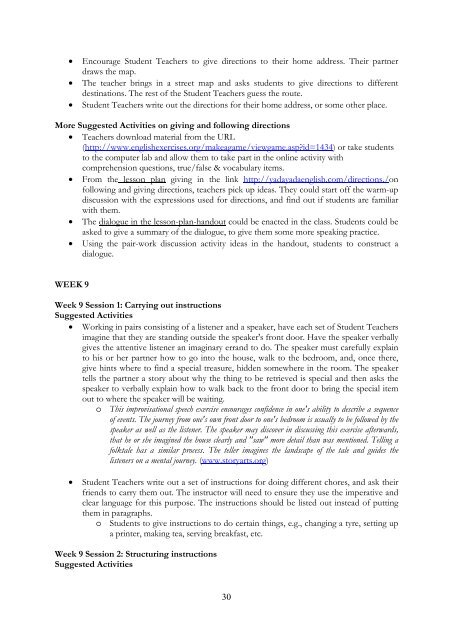Course Guide - USAID Teacher Education Project
Course Guide - USAID Teacher Education Project
Course Guide - USAID Teacher Education Project
You also want an ePaper? Increase the reach of your titles
YUMPU automatically turns print PDFs into web optimized ePapers that Google loves.
• Encourage Student <strong>Teacher</strong>s to give directions to their home address. Their partnerdraws the map.• The teacher brings in a street map and asks students to give directions to differentdestinations. The rest of the Student <strong>Teacher</strong>s guess the route.• Student <strong>Teacher</strong>s write out the directions for their home address, or some other place.More Suggested Activities on giving and following directions• <strong>Teacher</strong>s download material from the URL(http://www.englishexercises.org/makeagame/viewgame.asp?id=1434) or take studentsto the computer lab and allow them to take part in the online activity withcomprehension questions, true/false & vocabulary items.• From the lesson plan giving in the link http://yadayadaenglish.com/directions./onfollowing and giving directions, teachers pick up ideas. They could start off the warm-updiscussion with the expressions used for directions, and find out if students are familiarwith them.• The dialogue in the lesson-plan-handout could be enacted in the class. Students could beasked to give a summary of the dialogue, to give them some more speaking practice.• Using the pair-work discussion activity ideas in the handout, students to construct adialogue.WEEK 9Week 9 Session 1: Carrying out instructionsSuggested Activities• Working in pairs consisting of a listener and a speaker, have each set of Student <strong>Teacher</strong>simagine that they are standing outside the speaker's front door. Have the speaker verballygives the attentive listener an imaginary errand to do. The speaker must carefully explainto his or her partner how to go into the house, walk to the bedroom, and, once there,give hints where to find a special treasure, hidden somewhere in the room. The speakertells the partner a story about why the thing to be retrieved is special and then asks thespeaker to verbally explain how to walk back to the front door to bring the special itemout to where the speaker will be waiting.o This improvisational speech exercise encourages confidence in one's ability to describe a sequenceof events. The journey from one's own front door to one's bedroom is usually to be followed by thespeaker as well as the listener. The speaker may discover in discussing this exercise afterwards,that he or she imagined the house clearly and "saw" more detail than was mentioned. Telling afolktale has a similar process. The teller imagines the landscape of the tale and guides thelisteners on a mental journey. (www.storyarts.org)• Student <strong>Teacher</strong>s write out a set of instructions for doing different chores, and ask theirfriends to carry them out. The instructor will need to ensure they use the imperative andclear language for this purpose. The instructions should be listed out instead of puttingthem in paragraphs.o Students to give instructions to do certain things, e.g., changing a tyre, setting upa printer, making tea, serving breakfast, etc.Week 9 Session 2: Structuring instructionsSuggested Activities30
















